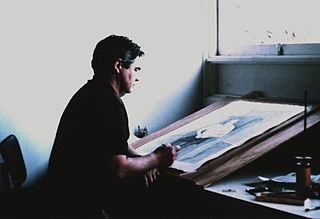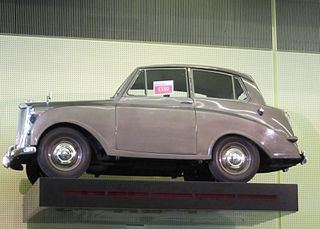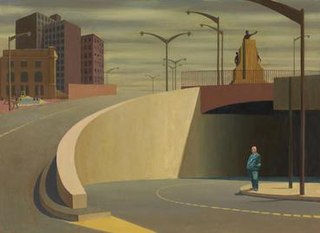
The National Gallery of Victoria, popularly known as the NGV, is an art museum in Melbourne, Victoria, Australia. Founded in 1861, it is Australia's oldest and most visited art museum.

The Ikon Gallery is an English gallery of contemporary art, located in Brindleyplace, Birmingham. It is housed in the Grade II listed, neo-gothic former Oozells Street Board School, designed by John Henry Chamberlain in 1877.

Grace Cossington Smith was an Australian artist and pioneer of modernist painting in Australia and was instrumental in introducing Post-Impressionism to her home country. Examples of her work are held by every major gallery in Australia.

Frederick Ronald Williams was an Australian painter and printmaker. He was one of Australia’s most important artists, and one of the twentieth century's major landscapists. He had more than seventy solo exhibitions during his career in Australian galleries, as well as the exhibition Fred Williams - Landscapes of a Continent at the Museum of Modern Art in New York in 1977.

John Brack was an Australian painter, and a member of the Antipodeans group. According to one critic, Brack's early works captured the idiosyncrasies of their time "more powerfully and succinctly than any Australian artist before or since. Brack forged the iconography of a decade on canvas as sharply as Barry Humphries did on stage."

The Antipodeans were a collective of Australian modern artists, known for their advocacy of figurative art and opposition to abstract expressionism. The group, which included seven painters from Melbourne and art historian Bernard Smith, was active in the late 1950s. Despite staging only a single exhibition in Melbourne in August 1959, the Antipodeans gained international recognition.

The Victoria Miro Gallery is a British contemporary art gallery in London, run by Victoria Miro. Miro opened her first gallery in 1985 in Cork Street, before moving to larger premises in Islington in 2000 and later opening a second space in St George Street, Mayfair.

An artist-run space or artist-run centre (Canada) is a gallery or other facility operated or directed by artists, frequently circumventing the structures of public art centers, museums, or commercial galleries and allowing for a more experimental program. An artist-run initiative (ARI) is any project run by artists, including sound or visual artists, to present their and others' projects. They might approximate a traditional art gallery space in appearance or function, or they may take a markedly different approach, limited only by the artist's understanding of the term. "Artist-run initiatives" is an umbrella name for many types of artist-generated activity.

The Gagosian Gallery is a modern and contemporary art gallery owned and directed by Larry Gagosian. The gallery exhibits some of the most well-known artists of the 20th and 21st centuries. As of 2024, Gagosian employs 300 people at 19 exhibition spaces – including New York City, London, Paris, Basel, Beverly Hills, San Francisco, Rome, Athens, Geneva, and Hong Kong – designed by architects such as Caruso St John, Richard Gluckman, Richard Meier, Jean Nouvel, and Annabelle Selldorf.

Hauser & Wirth is a Swiss contemporary and modern art gallery.

Collins St., 5 pm is a 1955 painting by Australian artist John Brack. The painting depicts office workers walking along busy Collins Street in Melbourne after finishing work for the day—"Blank-faced office workers hurry by like sleep-walkers, thinking only of the pubs or their homes in the suburbs". Brack conceived the work after reading T. S. Eliot's 1922 poem The Waste Land. It is considered a companion piece to Brack's earlier work The Bar.

Footballer is a 1946 painting by Australian artist Sidney Nolan. It depicts an Australian rules footballer standing before a crowd of spectators at a football match. For many years the painting was thought to be a generic image of a footballer, however Nolan later revealed that the painting is based on Bill Mohr, a star player for the St Kilda Football Club during the 1930s.

The Car is a 1955 painting by Australian artist John Brack. The painting depicts a family in a car on a drive in a rural area. The painting shows the father looking at the road ahead while the mother and children look towards the viewer. While the whole car cannot be seen, the car itself is identifiable as a Triumph Mayflower. The landscape, seen through the windows of the car, has been said to be inspired by the work of his contemporary Fred Williams.
Peter Bray Gallery was established as Stanley Coe Gallery in 1949 before being renamed in 1951, after a change of management. Situated at 435 Bourke Street, Melbourne, Victoria, Australia, it closed in 1957. Many of the major names in mid-century Australian contemporary art showed there during its brief, but very busy, lifespan.

Cahill Expressway is a 1962 painting by the Australian artist Jeffrey Smart. The painting depicts the Cahill Expressway, a motorway in inner Sydney. It is "considered by many to be one of his finest works" and "perhaps his best-known picture". The work has been described as "startling ... for its recognisability as an Sydney scene and doubly so for its timeless quality."

DabsMyla are a husband-and-wife team of artists from Melbourne, Australia.

Three of the Players is a 1953 painting by Australian artist John Brack. The painting depicts three Australian rules footballers from the Collingwood Football Club. The players are thought by some to be Lou Richards, Jack Regan and Phonse Kyne. However, Brack's widow, Helen, was of the opinion that they are not recognisable individuals but "stereotyped characters".

The Block is a 1954 painting by Australian artist John Brack. The painting depicts the interior of an empty butcher's shop, including the eponymous butcher's block. It is one of a series of paintings—including The Barber's Shop (1952), The Fish Shop (1955) and Men's Wear (1955)—of small high street businesses.
The tools of the trade – choppers, knives and meathooks – hang from the rails. The butcher’s block, centrally placed and painted in a darker tone, dominates the composition. Despite the rather grisly subject matter, Brack has achieved a small, perfectly contained and beautifully painted jewel-like interior. The detail of the brushwork, with its meticulous lines and opaque passages of thin paint in the background, the fine scratches incised into the block to indicate its use, and the artist’s handmade wooden frame, all converge in an exquisite synthesis
Gallery A was a mid-century Australian gallery that exhibited contemporary Australian art. It was established in 1959 at 60 Flinders Lane, Melbourne, and then relocated to 275 Toorak Road., South Yarra. A second Gallery A venue was opened and run concurrently at 21 Gipps Street, Paddington in Sydney from 1964, and a third in Canberra. The Sydney business largely displaced the Melbourne gallery, which also closed in 1970, and continued until 1983. Its founder was Max Hutchinson and other directors during the history of the gallery at its three venues included Clement Meadmore, James Mollison, Janet Dawson and Ann Lewis.

Latin American Grand Final is a 1969 painting by Australian artist John Brack. Part of a series of paintings on the theme of ballroom dancing painted by Brack in the late 1960s, the painting depicts two ballroom dancers – a man and a woman – in a dance competition.


















